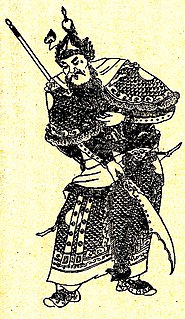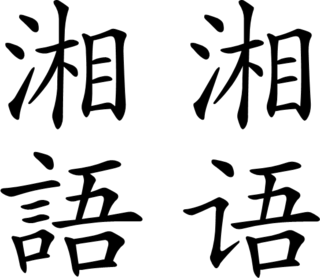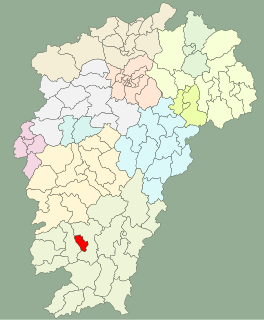
Jiangxi is a landlocked province in the east of the People's Republic of China. Its capital and largest city is Nanchang. Spanning from the banks of the Yangtze river in the north into hillier areas in the south and east, it shares a border with Anhui to the north, Zhejiang to the northeast, Fujian to the east, Guangdong to the south, Hunan to the west, and Hubei to the northwest.

Huang Zhong, courtesy name Hansheng, was a Chinese military general serving under the warlord Liu Bei during the late Eastern Han dynasty of China. He is best known for his victory at the Battle of Mount Dingjun in 219, in which his force routed that of an enemy general, Xiahou Yuan, who was killed in action during the raid.

Nanchang is the capital of Jiangxi Province, People's Republic of China. As of November 2017, the total population in Nanchang City was 5,246,600, while the built-up area made of 6 urban districts plus Nanchang county is home to more than 4,300,000 inhabitants. Located in the north-central part of the province and in the hinterland of Poyang Lake Plain, it is bounded on the west by the Jiuling Mountains, and on the east by Poyang Lake. Because of its strategic location connecting the prosperous East and South China, it has become a major railway hub in Southern China in recent decades.

The Chen dynasty, also known as the Southern Chen, was the fourth and last of the Southern Dynasties in China. Following the Liang dynasty, the Chen dynasty was founded by Chen Baxian. The Chen dynasty further strengthened and revitalized the economy and culture of Southern China, and even made territorial expansions northward, laying the foundation for future dynasties. It was conquered by the Sui dynasty in 589, marking an end to the Northern and Southern dynasties period in Chinese history. After the fall of the Chen dynasty, descendants of the Chen imperial family continued to hold powerful high-ranking positions in the imperial courts of both the Sui and Tang dynasties.

Xin Qiji was a Chinese calligrapher, military general, and poet during the Southern Song dynasty (1127–1279).

Xiang or Hsiang ; Changsha Xiang: sian1 y3, also known as Hunanese, is a group of linguistically similar and historically related Sinitic languages, spoken mainly in Hunan province but also in northern Guangxi and parts of neighboring Guizhou and Hubei provinces. Scholars divided Xiang into five subgroups, Chang-Yi, Lou-Shao, Hengzhou, Chen-Xu and Yong-Quan. Among those, Lou-shao, also known as Old Xiang, still exhibits the three-way distinction of Middle Chinese obstruents, preserving the voiced stops, fricatives, and affricates. Xiang has also been heavily influenced by Mandarin, which adjoins three of the four sides of the Xiang speaking territory, and Gan in Jiangxi Province, from where a large population immigrated to Hunan during the Ming Dynasty.

Zhanggong District is the administrative center of the prefecture-level city of Ganzhou in the south of Jiangxi Province, China. The oldest part of Ganzhou's ancient sewage system named Fushou Gou, which was built during the eleventh century AD and still in use today, is located in Zhanggong District.

Xiao is a Chinese surname. In the Wade-Giles system of romanization, it is rendered as Hsiao. It is also romanized as Siauw, Shiao, Sjauw, Siaw, Siew, Siow, Seow, Siu or Sui, as well as Shaw in less common situations, inspired by the transliteration of the surname of notable figures such as Irish playwright George Bernard Shaw and English actor Robert Shaw. It is the 99th name on the Hundred Family Surnames poem.

The Zhongshu Sheng, also known as the Palace Secretariat or Central Secretariat, was one of the three highest governing institutions in imperial China from the Sui dynasty until the early Ming dynasty. As one of the Three Departments, the Zhongshu Sheng was primarily a policy-formulating agency responsible for proposing and drafting all imperial decrees. The Song dynasty modified that tripartite division of executive agencies in the central government. Under the Song, Liao and Jin dynasties, those organs exercised much of the executive authority for the emperor.

Xiushui County is a county in the northwest of Jiangxi Province, China, bordering the provinces of Hunan to the west and southwest and Hubei to the northwest. It is the westernmost county-level division of the prefecture-level city of Jiujiang.

Cheng Tien-fong, was a Chinese educator, politician and diplomat. Cheng was a former President of Zhejiang University, and former Minister of Education of the ROC.
Gong Kai was a Chinese government official during the last years of the Song Dynasty. The latter part of the Song Dynasty, in which Gong Kai lived, is known as the Southern Song Dynasty (1127–1279). After the fall of the Song Dynasty to the Yuan Dynasty, he became what was known as a scholar-amateur painter. The artists of the Song were mostly influenced by momentary and sporadic pleasures and beauty. However, there is no evidence that Gong Kai painted during this period. Instead, most paintings attributed to Gong Kai are from Yuan Dynasty (1271–1368).
Guo Yuan was an official serving under the warlord Yuan Shang in the late Eastern Han dynasty of China.
Zhong Chuan or Zhong Zhuan (鍾傳), formally the Prince of Nanping (南平王), was a warlord of the late Tang dynasty, who controlled a large portion of Zhennan Circuit as its military governor (Jiedushi) for over 20 years.
Wei Quanfeng (危全諷) was a warlord late in the Chinese dynasty Tang Dynasty who controlled Fu Prefecture for over two decades, from 882 to 909, and who, at the prime of his power, also controlled three nearby prefectures. After the destruction of Tang, he held the territory for some time, but in 909 was defeated by armies of the new state of Hongnong, and his territory was seized by Hongnong.
Naghachu, also written as Nahacu, was an ethnic Mongol leader and general of the Northern Yuan dynasty in Manchuria, which was under Liaoyang province of the former Yuan dynasty. Originally a Yuan official, he had won hegemony over the Mongol tribes in a wide area including much of Rehe (Jehol) and Liaoning by the mid-1380s. Now he grew strong in the northeast, with forces large enough to threaten invasion of the newly founded Ming dynasty in order to restore the Mongols to power in China proper. Instead of waiting for the Northern Yuan to attack, in 1387 the Ming sent a military campaign to attack Naghachu and forced his surrender after a successful diplomacy of the Ming. Naghachu and thousands of his officers and relatives were sent to Nanjing, the capital of the Ming dynasty at that time. The Ming granted Naghachu himself a marquisate with a stipend of 2,000 piculs of grain, and estate of public fields in Jiangxi, and a mansion in Nanjing. He died near Wuchang on 31 August 1388, probably from overindulgence in alcohol, and was buried outside Nanjing.

The Yuan dynasty was a Mongol-led imperial Chinese dynasty. During its existence, its territory was divided into the Central Region (腹裏) governed by the Central Secretariat and places under control of various provinces (行省) or Branch Secretariats (行中書省), as well as the region under the Bureau of Buddhist and Tibetan Affairs. In addition, the Yuan emperors held nominal suzerainty over the western Mongol khanates, but in reality none of them were governed by the Yuan dynasty due to the division of the Mongol Empire.

Chen Wenlong was a scholar-general in the last years of the Southern Song dynasty and early Yuan dynasty. He became the City God of Fuzhou and Putian.

Jiangzhe province (江浙行省) was a province of the Yuan dynasty established in 1276. It included the southern portion of Jiangsu south of the Yangtze River, Zhejiang, Fujian and part of northern Guangdong. With capital was initially at Yangzhou, but in 1297 it was moved to Hangzhou Lu.

Henan Jiangbei province (河南江北行省), also referred to as just Henan, was a province of the Yuan dynasty in China established in 1268. It included the modern Henan, northern Jiangsu, and part of Anhui. The capital was Bianliang (Kaifeng).















